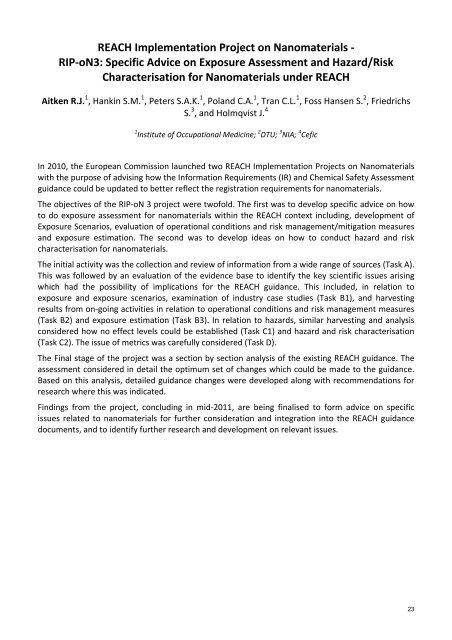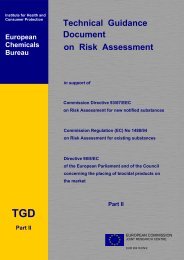Challenges of Regulation and Risk Assessment of Nanomaterials
Challenges of Regulation and Risk Assessment of Nanomaterials
Challenges of Regulation and Risk Assessment of Nanomaterials
You also want an ePaper? Increase the reach of your titles
YUMPU automatically turns print PDFs into web optimized ePapers that Google loves.
REACH Implementation Project on <strong>Nanomaterials</strong> -<br />
RIP-oN3: Specific Advice on Exposure <strong>Assessment</strong> <strong>and</strong> Hazard/<strong>Risk</strong><br />
Characterisation for <strong>Nanomaterials</strong> under REACH<br />
Aitken R.J. 1 , Hankin S.M. 1 , Peters S.A.K. 1 , Pol<strong>and</strong> C.A. 1 , Tran C.L. 1 , Foss Hansen S. 2 , Friedrichs<br />
S. 3 , <strong>and</strong> Holmqvist J. 4<br />
1 Institute <strong>of</strong> Occupational Medicine; 2 DTU; 3 NIA; 4 Cefic<br />
In 2010, the European Commission launched two REACH Implementation Projects on <strong>Nanomaterials</strong><br />
with the purpose <strong>of</strong> advising how the Information Requirements (IR) <strong>and</strong> Chemical Safety <strong>Assessment</strong><br />
guidance could be updated to better reflect the registration requirements for nanomaterials.<br />
The objectives <strong>of</strong> the RIP-oN 3 project were tw<strong>of</strong>old. The first was to develop specific advice on how<br />
to do exposure assessment for nanomaterials within the REACH context including, development <strong>of</strong><br />
Exposure Scenarios, evaluation <strong>of</strong> operational conditions <strong>and</strong> risk management/mitigation measures<br />
<strong>and</strong> exposure estimation. The second was to develop ideas on how to conduct hazard <strong>and</strong> risk<br />
characterisation for nanomaterials.<br />
The initial activity was the collection <strong>and</strong> review <strong>of</strong> information from a wide range <strong>of</strong> sources (Task A).<br />
This was followed by an evaluation <strong>of</strong> the evidence base to identify the key scientific issues arising<br />
which had the possibility <strong>of</strong> implications for the REACH guidance. This included, in relation to<br />
exposure <strong>and</strong> exposure scenarios, examination <strong>of</strong> industry case studies (Task B1), <strong>and</strong> harvesting<br />
results from on-going activities in relation to operational conditions <strong>and</strong> risk management measures<br />
(Task B2) <strong>and</strong> exposure estimation (Task B3). In relation to hazards, similar harvesting <strong>and</strong> analysis<br />
considered how no effect levels could be established (Task C1) <strong>and</strong> hazard <strong>and</strong> risk characterisation<br />
(Task C2). The issue <strong>of</strong> metrics was carefully considered (Task D).<br />
The Final stage <strong>of</strong> the project was a section by section analysis <strong>of</strong> the existing REACH guidance. The<br />
assessment considered in detail the optimum set <strong>of</strong> changes which could be made to the guidance.<br />
Based on this analysis, detailed guidance changes were developed along with recommendations for<br />
research where this was indicated.<br />
Findings from the project, concluding in mid-2011, are being finalised to form advice on specific<br />
issues related to nanomaterials for further consideration <strong>and</strong> integration into the REACH guidance<br />
documents, <strong>and</strong> to identify further research <strong>and</strong> development on relevant issues.<br />
23








